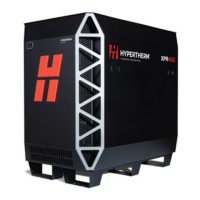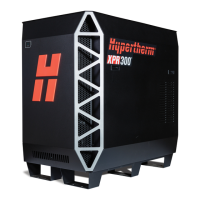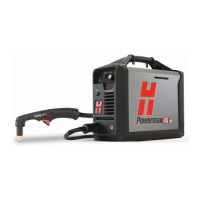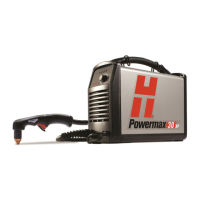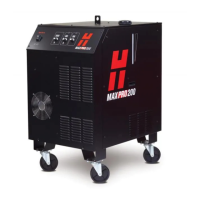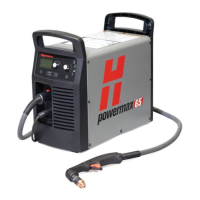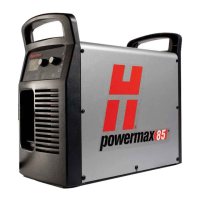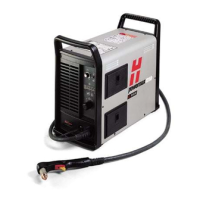Qualifications and Requirements
68 809480 Instruction Manual XPR300
Grounding practices
1. Unless noted, for XPR cutting systems, use cables with a minimum gauge of 21.2 mm
2
(4
AWG) (047031) for the EMI ground cables shown in the Example grounding diagram with an
XPR cutting system on page 71.
2. The cutting table is used for the common, or star, EMI ground point and should have threaded
studs welded to the table with a copper bus bar mounted on them. A separate bus bar should
be mounted on the gantry as close to each motor as possible. If there are motors at each end of
the gantry, run a separate EMI ground cable from the far motor to the gantry bus bar. The gantry
bus bar should have a separate, heavy EMI ground cable 21.2 mm
2
(4 AWG; 047031) to the
table bus bar. The EMI ground cables for the torch lifter and the RHF or combined ignition/gas
connect console must each run separately to the table ground bus.
3. Inadequate grounding not only exposes operators to dangerous voltages, but inadequate
grounding also increases the risk of equipment failure and unnecessary downtime. Ideally a
ground should be zero ohms resistance, but field experience indicates under 1 ohm resistance
is satisfactory for most applications. Hypertherm recommends that you consult your local and
national electrical codes to make sure that the grounding and shielding practices that you use
satisfy the requirements for your location.
4. A ground rod (a PE ground) that meets all applicable local and national electric codes must be
installed within 6 m (20 ft) of the cutting table. For XPR cutting systems, the PE ground must be
connected to the cutting table ground bus bar using a minimum 21.2 mm
2
(4 AWG) grounding
cable (047031). Consult an electrician in your location to make sure that your grounding meets
all local and national electric codes.
5. For the most effective shielding, use the Hypertherm CNC interface cables for I/O signals, serial
communication signals, between plasma systems in multi-drop connections, and for
interconnections between all parts of the Hypertherm system.
6. All hardware used in the ground system must be brass or copper. While you can use steel studs
welded to the cutting table for mounting the ground bus, no other aluminum or steel hardware
can be used in the ground system.
7. AC power, PE, and service grounds must be connected to all equipment according to local and
national codes.
8. For a system with a remote high frequency (RHF) console or combined ignition/gas connect
console, the positive, negative, and pilot arc leads should be bundled together for as long a
distance as possible. The torch lead, work lead, and the pilot arc (nozzle) leads may be run
parallel to other wires or cables only if they are separated by at least 150 mm (6 inches). If
possible, run power and signal cables in separate cable tracks.
9. For a system with a RHF console or combined ignition/gas connect console, Hypertherm
recommends that you mount this console as close as possible to the torch. This console also
must have a separate ground cable that connects directly to the cutting table ground bus bar.
10. Each Hypertherm component, as well as any other CNC or motor drive cabinet or enclosure,
must have a separate ground cable to the common (star) ground on the table. This includes the
ignition/gas connect console, whether it is bolted to the plasma system or to the cutting table.
